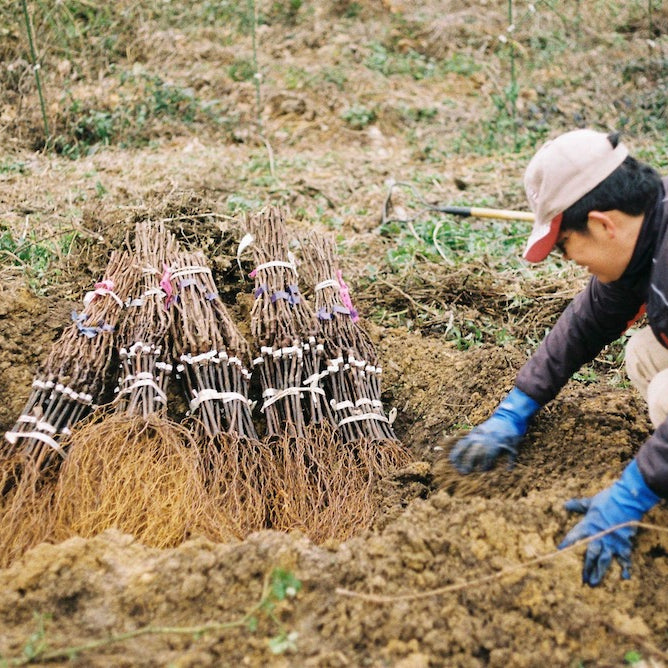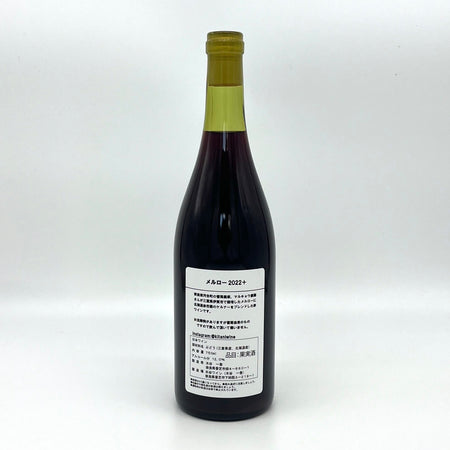Kitani Wine
Kashiba, Nara
From Banker to Vigneron
Located in Kashiba, Nara Prefecture, Kitani Wine was founded in 2022 as the very first winery in Nara. Its founder, Kazuto Kitani, was born in 1989 and originally pursued a completely different path. After completing his postgraduate studies at Kyoto University, where he researched diabetes prevention, he began his career as a banker. However, his frequent visits to Katashimo Winery in Osaka—a client of the bank—sparked a deep fascination with the world of winemaking.

Gradually, he became captivated by the idea of exploring what “terroir” could mean in his own birthplace, Nara. “If wine can be made in the area around where I live, maybe I can turn it into my life’s work,” he recalls. Guided by that conviction, he left his stable career and began training as a vigneron. After two years of hands-on experience at wineries in Osaka and Mie, he established Kitani Wine in June 2022.
For Kitani, winemaking is both a scientific pursuit and a craft of self-expression. “How we respond to the ever-changing weather and conditions each year—and how we express ourselves through those choices—is what makes winemaking so fascinating,” he says.
Challenging the Land of Nara

After becoming independent, Kitani rented several small plots of land: about 40 ares of abandoned farmland in Tenri, Nara, and two additional vineyards in Habikino and Kashiwara, Osaka. He quickly realized, however, that Nara is not naturally suited for grape cultivation. Its gentle topography and abundance of rice paddies mean that suitable vineyard slopes are rare. The land has also been divided into small parcels over centuries, making efficient farming difficult.
Still, it was precisely these limitations that fueled his curiosity. He wanted to discover and express Nara’s own terroir, even if the land was not ideal. “The challenge is what makes it worth pursuing,” he explains.

Today, Kitani cultivates around 3 hectares of vineyards scattered across Nara and Osaka, growing approximately 20 grape varieties. Some vineyards feature volcanic ash and sandy soils, while others required extensive restoration—removing old pergola systems and replanting with trellised vines. Among his grapes, he places special faith in Delaware, a variety that ripens beautifully in the Kansai region, retaining lively acidity and tropical fruit aromas balanced by the gentle climate of Nara.
Organic Practices and the Philosophy of “Subtraction”
Kitani practices fully organic viticulture, using no herbicides or chemical fertilizers. Only minimal amounts of Bordeaux mixture and lime-sulfur are applied when absolutely necessary. He finds joy in observing how nature responds when left to its own rhythm: “I’m curious to see what plants and creatures appear when we don’t spray anything. It’s part of understanding the natural order.”
He also embraces what he calls the philosophy of subtraction—allowing many shoots and clusters to grow, then thinning them at the right moment so that each remaining bunch receives the maximum energy from the vine. Both Pergola and Vertical Shoot Positioning (VSP) systems are used depending on the vineyard’s conditions.

In addition to his own vineyards, Kitani also makes wines using grapes grown by local farmers. This stems from his desire to contribute to the local community and revitalize Nara’s agriculture. “Someday, I hope that younger people will also be inspired to make wine in Nara,” he says.
Winemaking Philosophy – “Wines as Gentle as Water”

At the core of Kitani’s winemaking lies a minimalist approach: nothing is added unnecessarily. He uses no cultured yeast, no sulfites, no chaptalization, and no filtration. Instead, he lets the grapes’ own potential—and the year’s unique conditions—shape the final wine. Even the occasional off-flavor is embraced as a reflection of nature’s unpredictability.
His goal is to create wines that are as gentle and drinkable as water, yet layered with quiet depth.
“I believe water best expresses the terroir of Japan,” he says. “Because of our soft water and humid climate, Japanese wines tend to have a smooth, natural drinkability. I want to capture that ease, but also combine it with the subtle complexity of dashi broth.”
One of his most ambitious dreams is to “create a Dom Pérignon from Delaware,” redefining the reputation of this grape variety, which has long been associated with inexpensive wines in Japan.
The Logo and the Spirit of Connection

The Kitani Wine logo depicts three vine roots reaching out and intertwining. This symbolizes the merging of physics, chemistry, and biology underground—and the meeting of people, wine, and conversation above it. “Something interesting always happens when three elements come together,” Kitani explains.
He hopes these connections will extend beyond Japan to Europe and beyond:
“Honestly, I’m not sure how people in traditional wine regions will receive Japanese wines, but I hope they’ll enjoy the gentle texture and food-friendly character that make them unique.”
Image above: Ground-breaking ceremony to pray for the safety of the construction work by worshipping the gods of the land before laying the foundations of the winery.








